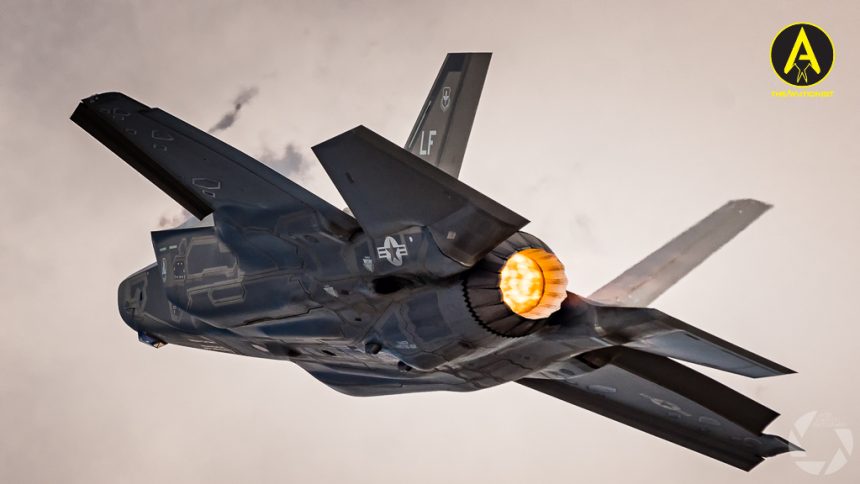“The F-35 was designed to operate in highly contested airspace, with capabilities precisely focused on what we have been seeing in Ukraine today.”
We have had an expansive chat with Billie Flynn recently. When it deals with the Lightning II, no one has Flynn’s knowledge. He is a 5th Generation experimental test pilot and airshow pilot who has been a part of development of the F-35. He authored the famous 2017 Paris Air Show routine that busted many myths about the Lightning II’s performance.
He can be considered a sort of global spokesman for the F-35 program and we interviewed him so as to have his view of the Lightning II stealth aircraft, as it becomes proliferated in Europe and is deployed to NATO’s Eastern Flank amid growing tensions with Russia following the invasion of Ukraine.
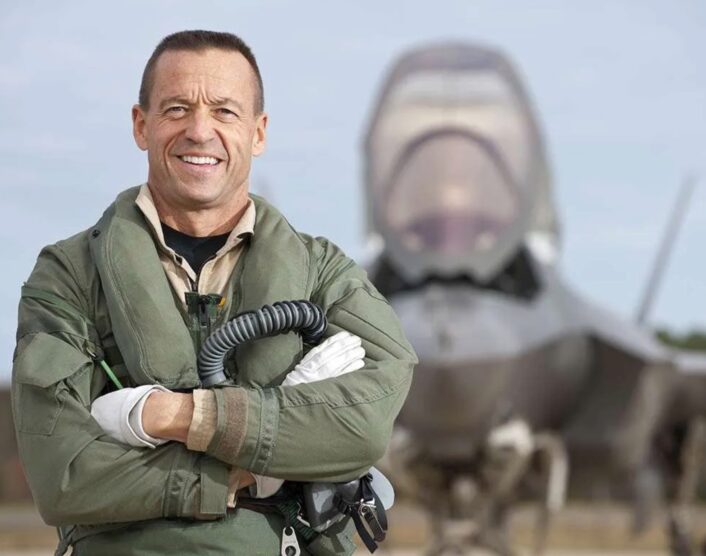
The Aviationist: Given the state of the Polish Air Force – how do you think Poland could integrate the F-35 in the Air Force? What the major challenges would be, when it comes to interoperability between the Lightning II, and the Polish Viper fleet? Where would, in your opinion, the F-35 fit?
Billie Flynn: So, let’s talk about the state of the Polish Air Force. Let’s use the F-16 integration as the first step in this example. I served in Europe and understood the Eastern Bloc’s capabilities. As a Lockheed Martin test pilot, I flew the Polish Block 52 aircraft during their acceptance flights and I’m very familiar with their capability. When the Polish Air Force took on the F-16, it took was a massive step forward to westernize a former Eastern Bloc air force, to (make them) understand how we think in the West and adapt to a very capable, very lethal 4th generation fighter. We see now, years later, how successful the training and the integration has been and how capable the pilots in the Polish Air Force are with that aircraft. So now the Polish Air Force needs to think how to integrate the F-35, building on that F-16 experience. I think that the successful integration of the F-16, and that huge leap forward that has been taken by the Air Force, will be mirrored when we look at the F-35.
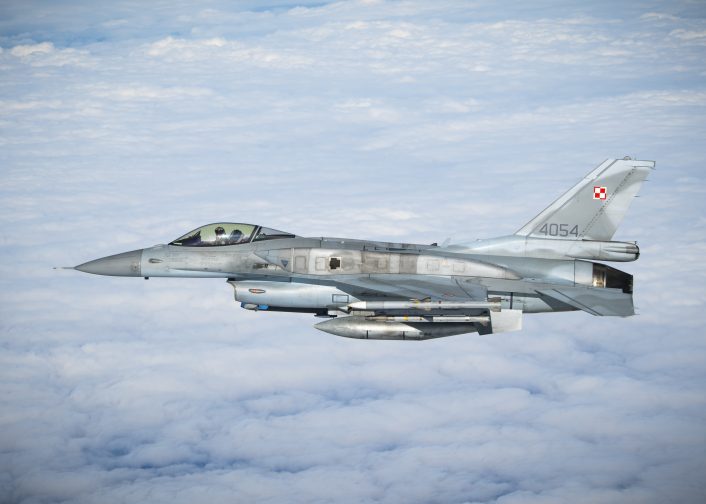
It would be essentially a foundation for the next steps, right?
Well, it shows the potential of the pilots, and the Air Force itself, to adopt something dramatically new. Because the F-35 is the most sophisticated fighter in the world today, bar none, dramatically more capable than the Block 52, the Eurofighter, or any other 4th generation jet. This 5th gen capability is astonishingly lethal. Remembering what the Air Force just did this over the past decades with the F-16 should give confidence that it will be able to integrate the F-35 with the F-16. Learning to leverage the F-35 advantages will keep the F-16s survivable. The F-16 is not survivable in the very highly contested world, like the Ukraine, for example, with significant numbers of sophisticated surface-to-air threats that the Russian Armed Forces have. The F-16 would never survive by itself. However, the F-35 was designed to operate in highly contested airspace, with capabilities precisely focused on what we have been seeing in Ukraine today. If you have F-35s, you do not necessarily need F-16s to do the damage that the F-35 would bring. They’re a monstrously capable and lethal platform, against SAMs or any kind of ground defenses or troops. But once Air Dominance is achieved, when you need additional firepower, you use the F-35 to protect the F-16s.
How would the F-35 fit in the Polish IADS – what could it do, how it could become a valid asset. We know that Poland has procured the Patriot MRAD, along with the IBCS network – so the F-35 can be plugged into it. What are the real-life benefits of this?
Here we start talking about multi-domain operations. Surface-to-air capabilities and airborne assets, integrate, operating in a joint, multi-domain effort: Instead of having separate forces – the air force, army, and navy will leverage the notion of joint capabilities. As you see with the F-35 plus the sophisticated anti-aircraft capability like the Patriot is, there is synergy in joint operations. F-35 brings sees so much with its sensors, like no legacy 4th generation platforms which help build a battlespace picture that would not be capable of being constructed with the other assets that would be flown. With that battlespace picture, and seeing the threats that are coming in, the Patriot comes into the equation.
So that really makes the F-35 a high value asset, right?
Truly, it’s more than just a tactical aircraft.
Do you think procurement of communication assets for legacy platforms is key? How could the Vipers talk to the Lightning, using MADL – should a pod be designed for that purpose, or should some new avionics be used – to benefit from the sensor fusion? How big the difference is in the comms department, as opposed to the 4th gen, and what impact does it have on the freedom of data exchange. What impact does it have on situational awareness, compared to the 4th generation aircraft?
Let’s talk about the two different methods of communications with datalinks and sharing information. Link 16, which is the NATO standard, both in 4th gen and 5th gen, is like a big lighthouse – and you broadcast your information everywhere, to everyone on the network. It’s omnidirectional, so it’s everywhere. And anyone can pick up that signal. If you’re transmitting as a part of a datalink network, you can be found, because you are an emitting source. That’s the first problem.
And the second problem is, there really is not a lot of sophisticated data that goes across on Link 16. It is essentially the position data, some elements of what weapons you are carrying and how much fuel you have, and some communications information that goes in the back and forth. But the F-35, and F-22, (each with a different format), the datalinks are designed as low probability of intercept stealthy networks. They are not omnidirectional, but instead uniquely directed on to those aircraft in the network, communicating with each other. Packets of data are sent directly back and forth but not in a continuous stream of data as in Link 16. Intercepting that data would be cosmically difficult to do and that’s how it remains stealthy.
When transmitting through MADL, no one can find the four, or eight aircraft in the network. F-35 is not just sending position data and simple communications but exactly what my aircraft sees in data-fused packets so that everything I see is shared with everyone else and vice versa. Our situational awareness is dramatically more comprehensive than anyone could imagine. Can a 4th Gen platform share this 5th Gen data? At present, no. Those 4th Gen airplanes cannot absorb or process the extraordinary amount of data that F-35 sensor fusion can handle. There is no processing capability in an F-16, or in an F-18, or in F-15EX, or in any other 4th generation airplane. In the future, we can perhaps design some data link that allows us to use a stealthier format to pass on information – and that way it’s not going to expose everyone on the datalink, the way the Link 16 does.
So, basically what you’re saying is – even if there’s a pod, or avionics designed for 4th gen, the remainder of the system would not be able to consume the data that the F-35 produces?
You’ve used the right term. They would not be able to CONSUME the data that the F-35 would transmit.
So, it’s Link 16 for now?
Yes, it’s Link 16 for NATO for now. As we’ve introduced the F-35 to NATO nations, think about Norway, the Netherlands, Italy, the UK and even now with Danish pilots are transitioning to the F-35, there is more incentive for us collectively, to figure out how to pass information to our 4th generation assets, without exposing us in F-35s. We need to get data to those platforms while staying safe in our sanctuary, operating as very low-observable fighters.
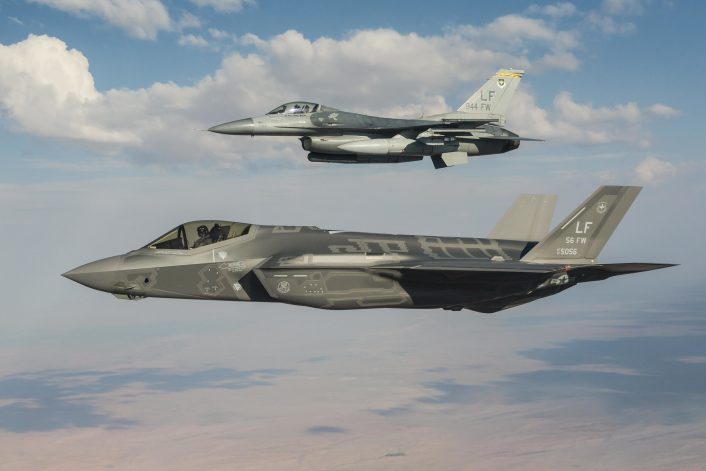
It can be said then that this is one of the major problems for figuring out interoperability between legacy platforms and 5th gen.
We have a lot of learning, and we are learning rapidly now, that the F-35 is in Central Europe. The F-35s participate in the Frisian Flag exercise right at this day, this week that we’re talking. We are learning how to use a 5th gen asset with the 4th gen platforms that are out there as blue air, as the good guys, and figuring out how best to optimize the F-35 and its lethality, but also how to keep the 4th gen platforms survivable. As we move forward, we will get smarter about exactly what will enable that better – moving forward.
In Poland, there has been this recurring myth on the Lightning II – those who question the procurement say that Warsaw does not need a deep-strike/SEAD/DEAD platform like the F-35 – calling it an offensive aircraft – and that we should procure an air superiority, defensive jet. Is the F-35 really solely an ‘offensive’ strike aircraft?
Well, the F-35 is a truly multi-role platform, in terms of defensive capability and offensive capability. But the aircraft that Poland will get will be able to carry six AMRAAM air-to-air missiles inside the weapons bay plus two AIM-9 or ASRAAM IR missiles, on the outward wing stations; that’s 8 missiles on the F-35 which is as lethal as anything else that’s out there. By the way, the picture of F-15EX with 22 AMRAAMs hides the fact that it could not take off with a maximum load of fuel, plus all those missiles at the same time. And no one has 22 AMRAAMs to load on a single fighter. A realistic loadout is six plus two that you will see in the later lots of the F-35. The F-35 is meant to protect other nations that have bought the jet, which are defensive in nature including Switzerland, Finland, and Canada In Finland, they’re worried about 1400 kilometers of border shared with Russia. In Switzerland, they would never anticipate flying the F-35 outside of their border, their job is to protect the nation. With its exceptional reach and sensor performance, across many spectrums, a very significant air-2-air loadout, and a stealthy platform, the F-35s will give those air forces a dramatic advantage over everything else. It is the most capable defensive platform out there.
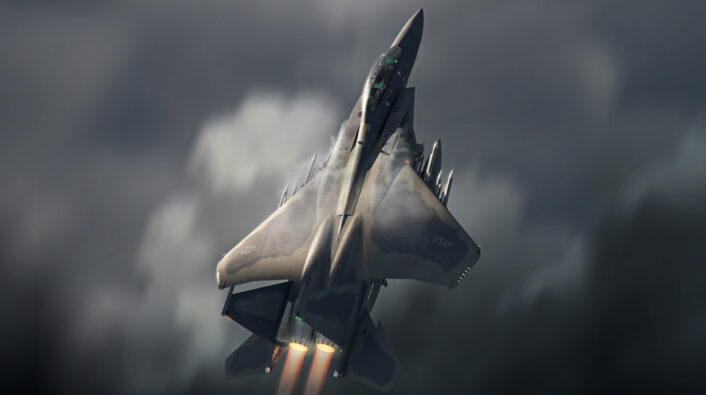
Somewhat related to that, here’s another question: there is a lot of talk, currently, regarding the capabilities of the F-35, and the meaning they may have for Poland in the wake of the recent geopolitical events. Some voices in the debate suggest that Poland would be better off procuring the F-15 – as it is faster, flies higher, and acts as a better kinematic platform for launching the missiles, with the mythical FL400 quoted as a reference altitude for the Flankers to fly at. Is this an area in which the F-35 would struggle – as we have seen in Ukraine, most of the strikes are done in a stand-off setting, and some experts claim that one needs a long stick to shoot the shooter? Are Germany and Finland wrong to procure the F-35 for the DCA role? How can the F-35 features be used in a DCA role?
The high-end speed of aircraft when they are clean, slicked off, is interesting. I was at 1.9 Mach when I was a Eurofighter Typhoon test pilot in Germany 20 years ago. I’ve been Mach 2.05 in the F-16 many times. For the F-35, its endpoint is 1.6 Mach. The two previous cases – the Eurofighter Typhoon and the F-16 – they cannot go to their maximum Mach number with their weapons and fuel loaded out. With their electro-optical Litening pods, Sniper pods, and equivalents – they can’t do their max Mach. The max speed of an F-15 – Mach 2+ – will never be achieved with a weapons loadout on the airplane because the drag on the outside will always prevent the jet from getting there. An F-35 will fly 1.6 Mach, with a weapons bay full of missiles and wingtip missiles, and I, as a test pilot have demonstrated that repeatedly. During the envelope expansion program, in my case flying the F-35B, and F-35C models I regularly at 1.6 Mach, with bombs and missiles in the weapons bay, and IR missiles on the outboard stations. F-35 flies 1.6 Mach which is necessarily faster than those two other aircraft.
Kinematics – In attrition warfare, where each airplane can see each other, whoever’s missile gets there first, hopefully kills the other airplane. With two missiles in the air there, one does not get to time out, because the launch aircraft died. You always wanted to be able to shoot first. To do that, you want to go as fast, or as high as you can to give your missile basically the fastest push – so it would go higher, faster, and get there first, before the other person’s missile hits you. That assumes that we both saw each other. And we’ve been playing this cat and mouse game of who gets missiles in the air, and who turns away from each other, to slow the closure velocity of the aircraft, as the missiles come out of each other, making the missiles fly further. It’s an old game of attrition warfare. But what happens when I’m in a very low observable F-35, and cannot be seen by the adversary, is that I to get to shoot my missile wherever I want before he (the other pilot) ever even knows I exist. My missile is in the air. My weapons bay doors have opened fired the missile, closed the weapons bay doors, and I may even have turned around, while my missile is impacting his jet. I am no longer playing the kinematic tactic that has been a part of our world for through all the years of 3rd gen and 4th gen weapons and fighters. I’m not trading kinematics as we did with 4th gen weapons.
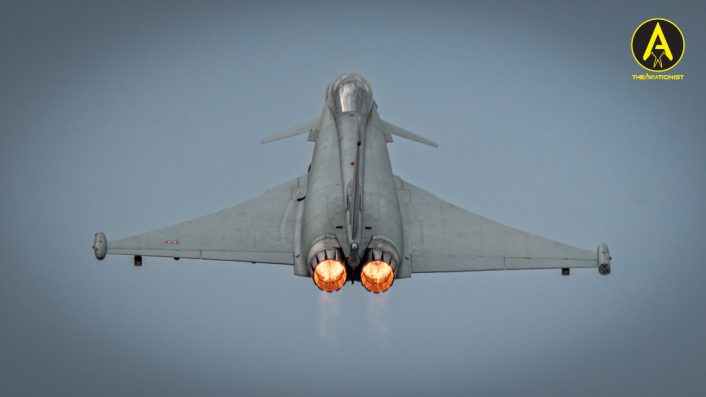
One last thing about the F-15EX: It is a wonderfully capable airplane. It will serve as a defensive capacity in North America which is why the US Air Force is buying it. The F-15EX is the last iteration of this fabulous design that’s been around for decades upon decades. It is based on the Saudi Arabian F-15SA that has since become Americanized. But it’s on its last life and there will be no major upgrades from this point on as opposed to the F-35, whose future growth potential looks out over thirty to forty years ahead. The F-35 remains at the beginning of its lifetime, not like the F-15EX, which is, necessarily, the last version of the F-15, and it does not have decades ahead of it – like the F-35 has.
Moreover, all those nations in Europe would be operating the F-35. Where the dedicated air superiority platform like the Typhoon was present, the F-35 comes in as an addition, but some nations had no air superiority platform in their possession before, like the Netherlands, Denmark, and so on. And they are not looking out to get the Eagle, right?
No, they are not. Use the F-16 example as the way forward when we talk about multi-role interoperability and what the F-35 will be. Remember, I flew the CF-18s in Baden-Soellingen Germany, and in a 4th gen fighter I went to the Tactical Leadership Programme to learn about NATO interoperability. The standard was the F-16. Air forces that had 2nd gen F-104s, F-100s in the case of Denmark, or F-5s, made the leap to the F-16 and learned how to fly and fight using the same type of fighter. Those air forces became great at the air-to-ground mission plus having an air-to-air capability that evolved over time.
The F-35 does those air-to-air and air-to-ground missions plus Suppression of Enemy Air Defenses, Destruction of Enemy Air Defenses, Intelligence, Surveillance and Reconnaissance. The F-35 performs every mission set. We learned in 4th gen how to fly together, how to share tactics and execute multi-role missions, with the F-16 as our baseline. With the F-35, everyone is flying the same platform, sharing data, between Danish, Italian, German, Dutch, Norwegian, Belgian, British, and American aircraft. But in 5th Gen we are not just dropping bombs, as an air-to-ground airplane or flying relatively simple air-to-air missions. In F-35, we are executing the most sophisticated mission sets ever in our air forces. The term that I use is not multi-role but instead multi-mission.
Regarding the multi-mission capabilities: Is CAS sortie flown by the F-35 very much different from one flown by the Viper? Has a new CAS doctrine been developed for the F-35?
We have learned how conduct CAS in the F-35 led by the US Marine Corps. The core doctrine of the US Marine Corps is to really protect the Marines on the ground and all assets are there to protect those Marines on the ground, fighting the fight. There’s a place for medium altitude CAS, operating in the sanctuary, targeting dropping the weapons required. The reality is that that does not work when the enemy is close. In an Iraq or Afghanistan type scenario, when you need bullets or weapons close to friendly troops, dropping weapons from 25,000 feet will not be acceptable. There’s a reality that you’d probably take any asset that would be brought down to the high-threat environment because you’re protecting troops on the ground.
I guess what I said to you is: medium altitude CAS exists, we’ve learned how to do that in Afghanistan and Iraq, but there may be a time when the troops are in contact and you’re going to come down and use the gun in the F-35, just like the Marines would have to do with a gun pod in an F-35B, and like the A-10 had to do over the years. That’s a lot of risk for an 80-million-dollar F-35 but our job is to protect the troops on the ground. We will become very good at medium altitude CAS, dropping JDAMs, Small Diameter Bombs, Paveway IV in the case of the UK. We will certainly work on those tactics but at some point, you do have to protect the troops on the ground.
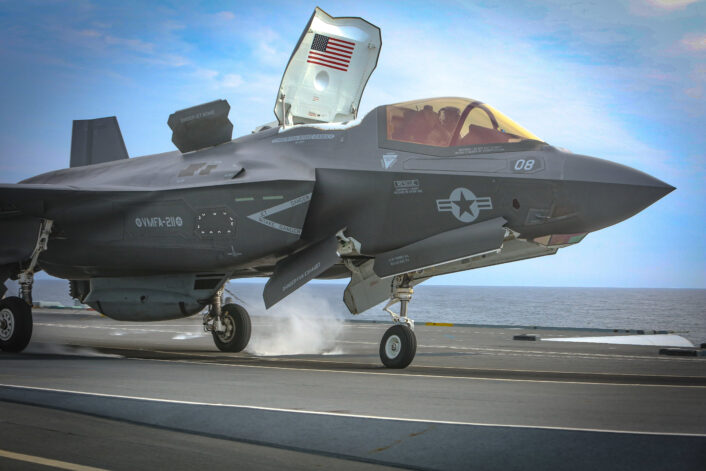
Or devise a new CAS platform.
Or devise a new CAS platform. We all love the A-10, there is no conversation ever that any aircraft can truly and effectively replace the A-10, even after all these years. Everyone on the ground will tell you that it has proven itself to be invaluable.
What about the self-defense measures and countermeasures that the F-35 uses – is the difference significant, as opposed to the 4th gen?
Absolutely. I am not going to talk about the specifics of what’s on board. But absolutely, the self-protection capabilities of the F-35 are more high-end that you will find on any 4th gen platform, anywhere in Europe. Absolutely.
Given your experience flying the F-35 and other types – has the myth that the F-35 is a poor dogfighter been busted already, during your Paris Air Show routine, or is this still a major problem? How effective the F-35 is in the BFM scenario – if it comes to it – because we know that this is an aircraft designed not to get into BFM – but still, if you were to take on a Flanker, how would it go?
Yes. We’ve busted the myth about the maneuverability of the F-35, when I flew in Paris, in June 2017, almost 5 years ago. That demonstration crushed the conversation about whether the F-35 was maneuverable or not. We showed the square loop, the slow speed pass at 35 degrees AoA, and performed a pedal turn at 50 degrees AoA, spiraling around at 50 degrees a second yaw rate. There’s only one other aircraft in the western world that can do that – and that’s the F-22 Raptor; it has thrust vectoring and we did not. We showed astonishing maneuverability. In the air show demonstrations shown by the United States Air Force F-35 demo pilots since then, they have reinforced the maneuverability and what the F-35 can do.
Do we still do BFM? We absolutely still train BFM. It’s one of those core skills to teach a pilot about how maneuverable his aircraft is. He (or she) has to get in there, and see how aggressive the aircraft can be, to gain the confidence in their own abilities and how to maneuver the aircraft aggressively and learn what the aircraft can really do. BFM will always be an essential skill we want to teach fighter pilots. Do I ever want to give up all of the amazing capabilities that I had in my F-35 leading into a merge – all the situational awareness I had, all the time I had to complete the kill chain, to kill the adversary, before facing him across the circle in a Top-Gun type fight? I would never want to make that mistake and miss those opportunities.
Would it happen? It would be so arrogant and mistaken to state that there could never be a BFM fight in an F-35. What’s the aircraft like to fight in BFM? I was originally a CF-18 pilot and then later in my career I’ve spent much of my time in F-16s and Eurofighter Typhoons. These fighters have different flight-control logics. The Hornet loves to fly slow. It has that incredible capability in slow-speed maneuvering whereas the F-16, Gripen, Eurofighter and Rafale are all meant as high-speed fighters. They have 9G limits and they’re really meant to go around the corner, chasing the adversary, quickly and fast. They are beautifully flying airplanes, even at the aggressiveness of the 9G. But it’s two different philosophies. One tries to point its nose quickly at the adversary and shoot quicker – like the F-18 – and the other one tries to race around the circle faster – F-16, Eurofighter, Rafale, Gripen.
The F-35 is more like an F-18 – remember the air show demonstrations of 50 degrees AoA, and a square-loop, and pedal turn. That’s what its highlight capability is – different than F-16 or the Typhoon. It is just a different philosophy. Where should the F-35 advantage be? As a minimum, I should enter the combat environment having seen my adversary long before he could see me with a significant advantage even before the fight starts. That’s really what the F-22 had learned over all these years. When they allow themselves to get into air combat, they have a huge advantage, because they’ve seen the adversary much, much earlier than the adversary sees them, so the fight typically ends much quicker like that.
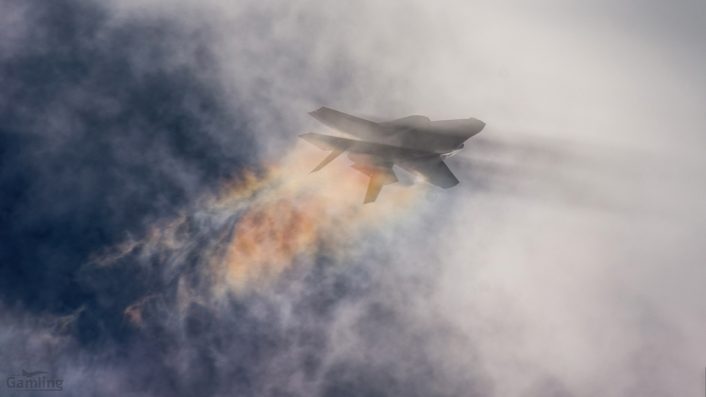
So, the F-35 is more of a nose-position fighter, than a circle fight type airplane?
Yep.
There is a great deal of talk about how low RCS has an impact on air combat. What does it mean for a pilot – in practical terms, when it comes to fighting – in OCA and especially in the DCA setting – let’s talk about some hypothetical, real-life scenarios here?
There really is a transition in how you think – remember, I’m a 4th gen baby, CF-18, F-16, Typhoon – and then I learned how to fly the F-35. It was hard for me to understand at the beginning that the adversary can’t see you. Instead of being defensive as you approach your adversary, assuming that he has already seen you, and always watching for someone entering and attacking us, you’re now looking ahead in the F-35, knowing he does not see you, and knowing that you see everything out there. That switch to the offensive mentality is a complete change of mindset. When you learn to believe, when you learn to accept that you really are invisible, that’s when you become incredibly potent with the F-35. That’s when you start killing the adversary quickly. We have seen, time and again, whether it’s Red Flag exercises, other large-scale exercises, in deployments overseas, or as we saw when I led the F-35 deployment for Finland’s H-X Challenge just how capable the aircraft is. It’s not a fair fight, and I don’t ever want it to be fair. I want us to be 20:1 better than the adversary, or even more dominating than that.
So, was the 20:1 figure in the Red Flag a marketing figure, or an oversimplification?
No, it was not. It’s the real thing. Much like the F-22 demonstrated for so long – nobody beats F-22. They have been dominating for their entire operational life. Now the F-35 shows up and we’re winning better than 20:1 in the most aggressive scenarios against adversary pilots who are better than the Russian pilots ever would be. The western fighters who pretend to be the adversaries, the Red Air as we call them, are more capable than the real Russian aircraft are. And yet, we still win better than 20:1 in the highest contested environments, which are very much mirrored to what we have been seeing in Ukraine now.
Given the proliferation of the F-35 among European users, do you think that the F-35 is on its way to becoming the next standard fighter for NATO, like the F-16 and the F-104 did in the past?
It’s going to be like the F-104 was as a 2nd Gen fighter and the F-4 as a 3rd Gen fighter. The 4th gen NATO standard was the F-16, a franchise program with more than 4,700 of them built thus far and Lockheed Martin building even more. The total number of F-16 built will surpass 5,000 ultimately. Now you see how the F-35 has gained so much traction. It has proven itself with the United States Marine Corps, Air Force and Navy, the Israeli Defense Force, in the UK now. Every user loves what this aircraft can do. There will be more than 3,000 F-35s built over their lifetime. It’s THE platform of 5th gen. It’s a franchise platform, as I call it.
So, a 5th gen. franchise…
Yes, as the F-16 was. The F-16 over all the years evolved from this lightweight fighter, with a very poor radar and only an AIM-9 capability to this incredibly capable, lethal airplane that it is now; the iterations of Block 52, UAE Air Force F-16 E/F Block 60, or the now emerging Block 70. It’s remarkable how the capability of the Viper grew over the years. You will see that same pattern of growth with the F-35 over its lifetime. It is the NATO standard already. Germany with 35 aircraft that are not going to be just nuclear-capable delivery airplanes, replacing Tornado. The Luftwaffe is now going to find out that they have this astonishing, capable new aircraft that does every mission set better than any other platform. Those aircraft will transform and push the Luftwaffe, as happened with other air forces, dramatically higher in capability than they could’ve imagined.
So maybe we’ll see a future German procurement of more F-35s?
I don’t know. I’ve spent many years as a German test pilot, and I recognize how important the industry is there. But I do think the 35 aircraft will transform the Luftwaffe, its philosophy, and what the air power can do in the mission sets that it performs.
For Poland to adopt the F-35, do you think procurement of AEW, and tankers would be a beneficial force multiplier?
I think we will, collectively in NATO, rethink our airborne early warning platforms. Clearly AWACS has done amazing service, it has taken us through the first Gulf War, through my experience in combat in Kosovo in 1999, to Iraq, Syria, Libya, since then, right? But it’s at the end of its days. We see the effective Wedgetail, first in Australia and now has the interest of the USAF. We’ve seen what that kind of capability does and why it’s interesting to have a platform like that. 5th Gen fighters like F-35 gather so much knowledge of the battlespace.
But to ask an individual pilot to orchestrate and be that commander of the overall battle is probably too much for that one person in the cockpit. If that information comes back to a AEW platform that has great capabilities, but also can coordinate the air battle based on all that knowledge gathered by the fighters and then dictate and task the fighters to prosecute the battle plan. In that case you are effectively using a platform to allow them to control the battle much like AWACS did a generation ago back in 4th gen. Does Poland acquire such a platform, or does NATO evolve and pick a NATO platform that all NATO nations can contribute to, as happened for the NATO AWACS in Gelsenkirchen where it has been based for so many years? Yes.
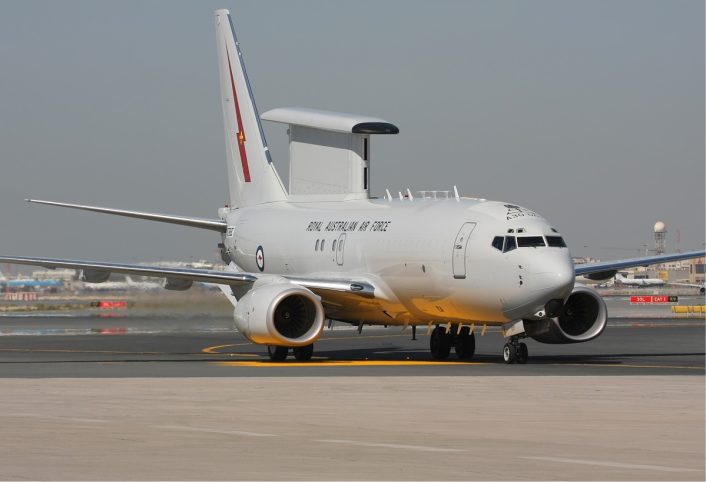
Do you need tankers? Does NATO collectively need more tankers? Absolutely, if they are going to deploy like we ended up in Kosovo, back again 20+ years ago, when we needed airborne refueling assets to allow us to go deep into Serbian territory. Or, in our case today potentially, into Russian territory. The nations, collectively, need tankers. Do individual countries need their own tanker assets? I do not think so because the F-35 has more range and better persistence than any other legacy fighter. The F-35A has 18,500 pounds of internal fuel which is more gas than is carried by a legacy F-16, or Typhoon, or Hornet. All that fuel means that the F-35 can go further, and stay airborne longer, than even the F-16, which has really good legs. I do not know if you need tankers as individual nations. NATO has to look at the tanker assets and decide what the nations collectively need.
So, this goes back to the Eagle: do you say that Lightning has a longer loiter time, station time, than the F-15?
This depends, if we’re asking Eagle to carry 3 fuel tanks, is he loitering now, does he have a lot of missiles on the outside, which adds to its drag? The F-35 has a very efficient, 5th generation Pratt & Whitney F-135 engine. It was designed like a commercial engine, more efficient than any of the 4th gen fighter engines could be. Those 4th gen engines are based on 40-year-old technology, as opposed to much more advanced 5th Gen technology. The F-35 is more efficient when it’s airborne, has less drag, and carries a lot of gas. It can sit on station a long time. I flew a long, long time, being airborne in the F-35 for all those years, a lot longer than I ever did on those legacy platforms like the F-16, F-18, or the Typhoon.
F-35 and legacy airframes (F-16/F-15/MiG-29). How much training is needed to cross between the two?
OK. When I answer this, all of the MiG-29 pilots in Poland that I know, that I knew back in the airshow days, are going to hate me. And they never going to speak to me again. Will the F-16 pilots transition to the F-35? Absolutely which is what happened with many of the air forces that transitioned to F-35 already. We had to take the experienced pilots, from the Netherlands, Norway, as examples, and let them transition to be the tactical leaders in the new F-35 squadrons as their air forces learn to adopt the F-35. Only then can you eventually bring in the young pilots who only know the F-35. But to start you have to transition those 4th gen pilots, who have the airmanship, the tactical leadership and flight-lead experience to be the core of the future squadrons, They are going to be the senior Captains, Majors, and Squadron Commanders. There is no place for the MiG-29 pilots in the sophisticated world of 5th gen, with a transition made directly to the F-35.
Even now the Polish Air Force is separated. There’s very much the Russian, Eastern Bloc mentality vs the Western F-16 cadre. And those fighter pilots do not cross back and forth between MiG-29 and F-16. For any pilot, it is such a leap to go to the F-35. Asking a very capable MiG pilot to transition to this cosmic spaceship is far too much to grasp. Every part of how we mechanize the aircraft in the West is different from how Russians design their aircraft, every part of philosophy of how you fly an airplane, how you design cockpits, how you process information is different. To say to an F-16 pilot: Hey, we’re Lockheed Martin, and we build the aircraft the certain way, and switches the certain way, and now we’re going to give you the next generation of that, there’s a logic flow of our design, of the F-16, as the baseline, that kind of looks like what the F-35 is. This is a logical step forward. That does not exist for the MiG cadre. And I think the MiG cadre will end up atrophying, spending their time in that jet until the MiG-29 phases out. You need to take the F-16 cadre and make them move forward to the F-35. That is going to make me very unpopular with the MiG-29 guys in Poland.
How much training would be needed between the Viper, and the Lightning? Is it a long program?
I think here we shall look at what the other nations have done. Remember our example, like the USAF – with lots of F-16 pilots converting to F-35, we see the Netherlands, Norway, and now Denmark. We’ll see Belgium send their F-16 pilots to convert to F-35 at some point. We know that there’s a transition of experienced pilots, from every F-35-user nation, to be pushed through the F-35 training system. It is a mature pattern right now around for years since that we’ve been out training pilots for these aircraft to be operational. We obviously do not actually know how long it will take for Polish Air Force pilots to transition to the F-35whether it’s 6 months, or 9 months, or 10 months. But there’s a system in place now.
An oddball question, but as a test pilot who actually took part in development of that system: what are your thoughts on A-GCAS? Is it a nuisance, or a great asset? The second part of the question refers to the claims made by Soviet pilots back in the day, as back in the 1990s there was a real fear of fly-by-wire, as the Soviet pilots quoted in the old Wings of the Red Star series stated. They claimed that it can be a thing that prevents them from gaining advantage, if it does not let them conduct a much needed maneuver in given circumstances? Do you think Auto-GCAS would be a problem for a really experienced guy, who knows what he’s doing? Is it a nuisance?
Let me explain so the people reading this will understand. The Automatic Ground Collision Avoidance System is this capability where the aircraft senses that it’s going to impact the ground, whatever the terrain is – mountains or the flat ground. And it says: Look, for some reason the pilot has not done anything. I’m going to take control from the pilot, I’m going to orient the aircraft upright, fly away from that terrain and then I’ll give back the control to the pilot. In the period from 2009 to 2011, I was a part of the Lockheed Martin’s Skunk Works Team – a very famous name – along with NASA and USAF team that matured the technology for Auto GCAS. That technology was later fielded in the F-16, and more recently in the F-35.
A derivative of that Auto GCAS design went to the US Navy, and it’s going into Super Hornets and legacy Hornets. There are so many guys that we’ve known, in every air force, who have hit the ground over the years, for so many reasons. It’s disorientation, inexperience, of loss of consciousness from pulling too much G. There’s a host of reasons, Controlled Flight Into Terrain as it is called is an indiscriminate killer. It kills young and old, experienced, and inexperienced, day and night and there is no common denominator.
Over the years CFIT has killed so many that everyone else knows someone who has died. And Auto GCAS now is essentially flawless. When it takes over, it is beyond the threshold of what the human could tolerate. As a test pilot during its testing, I could never fly myself past the limit, of when Auto-GCAS would take control from me. When it takes over, you’re really beyond what the human can stand, and you really are going to die. In a pilot’s lifetime, he will likely never see the Automatic Ground Collision Avoidance System activation because he’s never going to fly that close to the ground, orient himself upside down or try to kill himself by flying that way. If and when Auto GCAS comes on, it’s meant to save you.
There are YouTube videos of an F-16 where the system activates and saves the life of the pilot who has blacked out and is going to die. Auto GCAS orients the airplane and flies it up away from the ground and saves him. He would have died if auto-GCAS had not be in the jet. So, nuisance? There is no sense of nuisance with Auto-GCAS. It is the most important contribution to the flight safety in the past 50 years, since fly-by-wire technology was introduced in the western world. The Auto GCAS team was awarded the 2018 Collier Trophy which is the highest award in aviation and is given out be the National Aeronautic Association, because of just the potential of this technology to save lives. I think that we should all be thankful that Auto-GCAS is in the F-16, and F-35, it’s now going into the legacy and Super Hornet fleets. Seven of the sixteen fatalities in the Canadian CF-18 over its 40-year lifetime were from hitting the ground where Auto-GCAS could save lives.
As time moves on, Auto GCAS will continue to save many, many lives, and billions of dollars in assets, over many, many years to come.
Let’s hope it goes into general aviation soon as well.
Yes, that’s really the future, right? Like a lot of technologies in the military world – think of the HUD – which we’ve flown for forty years and now, many years later after proving itself in fighter jets see it in modern day GA, or 787, or C-17, or C-130J. You will see an Automatic Ground Collision Avoidance [System] in the 737 at some point. You’ll see it in a Gulfstream jet, Bombardier Global Express or Dassault’s iteration of corporate jets at some point in the future.
Coming back to the F-35:. How does it feel to fly using DAS to look through the airframe? Does it feel weird? Is it a useful concept? How does it compare to Striker or JHMCS?
Distributed Aperture System, as you know, is a meshing of six mid-wave IR cameras that are flush mounted on the aircraft. There are two DAS cameras in the sides, two at the bottom, front and back, two at the top, front and back. Those six cameras build a huge picture that is stitched together, to spherically give an infra-red image around the airplane. Wherever you look in your helmet, you see, when DAS is turned on in the helmet, this infra-red hot and cold contrasted image. As you say – if you look between your legs, underneath the aircraft, you see as if the skin of the airplane is not there. During the day, I seldom found a practical application to have the DAS image projected on my helmet because you and I could look out and see what’s on the ground with the naked eye. But at night, I can speak about flying over the East Coast of the US or over the mountains of California, with zero Moon, and all of a sudden, I see, with perfect orientation, the mountains, highways, electrical power lines, rivers and lakes, and while it’s not daytime acuity, I have remarkable situational awareness and essentially see as I would in the day.
That kind of situational awareness allows me to treat flying at night much more matter of fact as when I am flying during the day. That is not the case without DAS when it is pitch black outside, and I don’t have any orientation at all. DAS gives me a view so I can see everything around me and orient myself better. In the F-35 we essentially treat night-time missions like daytime missions. We fly some place up in the sky, where no one sees us. On our screens, there’s no difference between day to night. With DAS I have better orientation looking around to allow me to feel more comfortable at night than I would in a legacy platform.
If you ask about the Joint Helmet-Mounted Cueing System, or Scorpion, which is another version of a monocular helmet, I will tell you that they are dramatically less capable than the F-35 Helmet Mounted Display. JHMCS, as a monocular helmet displays on a single eye where my targets of interest are, and in some cases, it gives me some information about the airplane state. But that image is not the stereoscopic view that I get from the F-35helmet. DAS does not exist in the Striker helmet either. Although Striker is, by all accounts, a very capable helmet. I think that when you’re talking about the F-35 helmet, you’re talking another order of magnitude in capability to aid the pilot. The F-35 HMD is seamless for the pilot to wear and use and we’ve matured all of the growing pains over the many years of testing. We have figured out the problems with it along the way and fixed them. You could fly the F-35 without it, but why wouldn’t you want the helmet on your head? I regularly flew 5-hour missions at Pax River in Maryland on the east coast of the US, and over the ocean, doing testing in F-35Bs and F-35Cs. It sat on my head, and I never noticed any part of it being heavy, or out of balance. It was a seamless part for me. I really want the helmet to be able to look out and understand what the display is telling me with all my targets projected so that I do not have to translate that onto a touch screen in front of me.
There is a real enhancement to my lethality and effectiveness, with the helmet on my head.
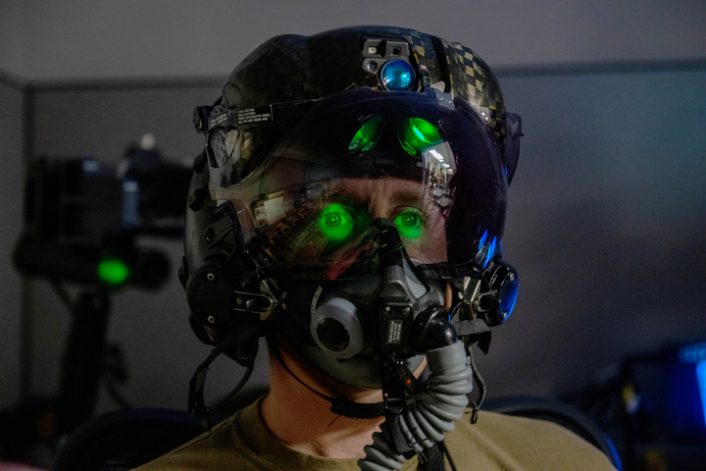
Is the fitting process slow for the helmet?
Well, it does take time. It’s easy to project an image on one eye. Or either eye. But to get both eyes focused, so I’m not confused, with them being exactly focused, so I am kind of looking at a movie screen – that takes time. We’re much more sophisticated now in how we adjust this, when we fit a new helmet to a pilot. In the beginning, we were not as efficient and had to learn the techniques. Now the process is much easier. For a human to adapt to wearing the helmet is intuitive, and simple to use; Pilots adapt to it right away.
Could you please comment on the photos we have posted of the F-35s without radar reflectors doing patrols over Poland near Ukraine? Is this giving away the signatures to the potential adversary?
I’m not going to comment on that. What I will say though is that having the F-35 on the eastern flank of NATO, where they are deployed now, is a significant deterrent to Russia continuing their ambitions to push further eastward. Because the F-35 represent an extraordinary lethal threat. The F-35 was designed precisely for an environment that we are seeing in Ukraine now and its capacity to neutralize the enemy cannot be matched by any other airplane that flies in anybody else’s air force. So just the fact that the F-35s are there, scares everybody on the other side.
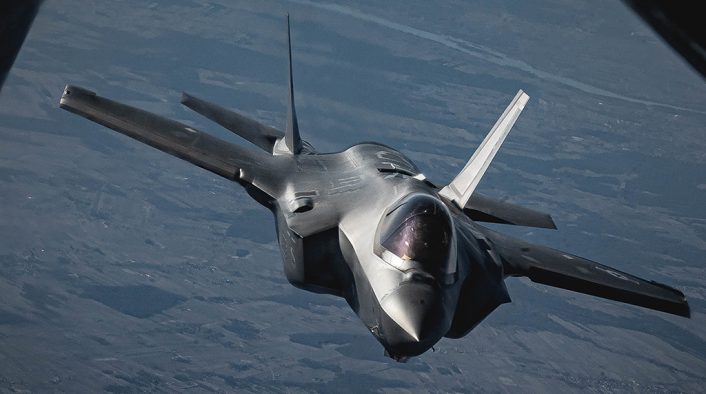
The Ukrainian air war seems to be an old-styled conflict, with many reported aerial engagements and aircraft flying mainly low level. How would the F-35 perform in such a scenario?
First of all, as we all watch what happens in Ukraine, we are witnessing the incredible courage and bravery of the men and women who are defending their homeland, against the Putin’s war of choice. It is miraculous how they have performed thus far, in really deterring the Russian army and doing damage to the significant force that has invaded. I think this has surprised everybody around the world. They are true warriors and heroes. We have seen that the Russian style of warfare is so different from what we have imagined in the West. We saw glimpses of their complete, indiscriminate bombing, old-school tactics in Syria. This style of warfare is certainly not how we in the West have evolved in our very sophisticated way to use our very potent assets. NATO does not want to be dragged into this war, because bringing us in escalates this beyond the conflict in Ukraine and makes it, essentially on its way to WW3. It’s an escalation we collectively know we could not control. If we consider what a fifth gen capability contribute to a theater, like in the Ukraine, recall that the F-35 was designed precisely to fight this high-end fight.
F-35 with a stealth platform that cannot be seen and excels at the Wild Weasel mission flown for years by the F-16. The F-35 is exceptionally capable at executing the Suppression of Enemy Air Defenses mission set. It would go in and kill every surface-to-air missile threat that was out there, and neutralize all the threats on the ground, and achieve air dominance because it would kill all the air-to-air assets also. Remember: we see them, they don’t see us. It’s like playing football, when one team’s invisible, and the other team is not with a gross advantage on behalf of the F-35. F-35 would see all the enemy air-to-air threats and kill them all, plus completely neutralizing the surface-to-air missile threat to achieve air dominance. From that point, the forces can conduct their air-to-ground war. That’s what the F-35 was meant to do. So, in a parallel world, because we do not want to be dragged into the Ukraine, the F-35 would completely destroy the Russian forces.
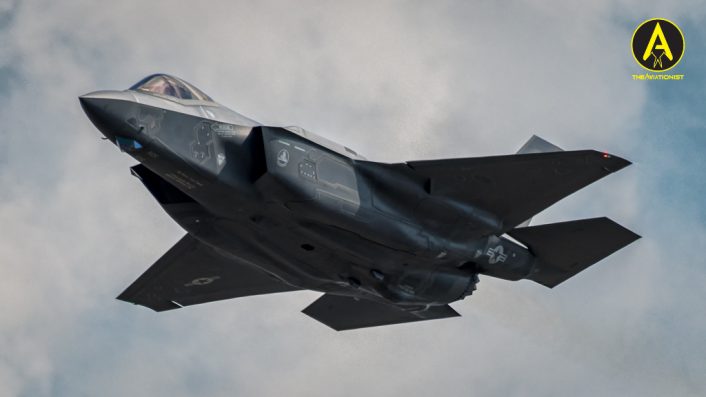
Could you comment on EW/ESM capabilities the F-35 has, compared to 4th gen platforms? Many air forces are going to replace their SEAD aircraft with the F-35. Along with the EW and ESM capabilities don’t you think the aircraft still miss a dedicated Anti-Radiation Missile – is AARGM-ER a valid option here?
As I said before. The F-35 was designed for the SEAD mission. It’s designed as an VLO platform that is capable of identifying targets on the ground and neutralizing them. That’s where the weapons capabilities that come already with the F-35, are perfectly suited for the SEAD mission. Does it have a very potent electronic warfare capability, electronic attack capability? We have talked about that in public briefings for a long time and I certainly briefed it in Poland when I came to discuss the F-35’s capabilities. That possesses a very lethal capability in terms of electronic attack – that’s jamming – and also in terms of self-protection. How you use that in combination with a stealth platform is part of the tactic of staying survivable with an F-35 in a highly contested environment. Managing our signature, how you could see us or not see us, is hugely important. It serves no purpose to be stealthy in the radar environment, but emitting electrons all over, and so everyone can see us because we’re emitting electromagnetic energy. How we manage our energy signature is secret to us staying unobserved.
Last question: could you please comment on partner nations using the F-35 just for QRA. Isn’t it overkill? Isn’t it a waste of resources?
No. F-35 is a jet that’s meant to sit on QRA as it does right now in Norway, and by the way when F-35s are deployed to Iceland. I expect the F-35 to be able to be flashed up and sent airborne as quickly as possible. F-35s will sit on QRA in Canada and the United States for NORAD missions. F-35, once it gets airborne its sensors can see further than any other legacy platform and is perfectly suited for that intercept mission.

What should I have asked you that I did not?
We talked about a lot of questions that people have about the F-35. And it’s important that we answer those questions because the doubts remain until those nations start to use the F-35. Once the national pilots come home speak about F-35’s capabilities, the doubts fade. We saw this in the Netherlands, when the Dutch pilots were able to speak about flying the F-35 and how they really believed in the aircraft. They talked about how it really is more effective, more survivable, more lethal, than they ever imagined, and this changed people’s views on the jet and the program. We see that confidence from Italian, Norwegian and certainly from the United States Marine Corps pilots, as the leading F-35 service in the United States. If you went to Israel, you’d find the same answer. So, I think it’s important that we ask all these questions now – to help build the confidence until the aircraft shows up. Because then you are going to find out from the Polish pilots that they think the jet is astonishing. It’s not marketing. It truly is as effective, survivable, and lethal, as we all imagine.
Let me finish by saying: for so many of us warfare was going to be relegated to an asymmetric warfare style for now, and for decades to come. It was the Balkan conflicts in the early 1990s, Kosovo in 1999, Iraq, and Afghanistan, it was. There were never going to be large scale conflicts again. Peace had broken out, post-Cold War, and we were never going to have the world’s largest most powerful forces fight each other again. The world has had a real awakening in the last 35, 36 days showing that this is not true anymore. we see that WW3 is a real possibility. And we are not going to get over the threat of Putin and Russia for decades to come. We in the free world have been threatened. We are collectively stronger, as NATO, than anyone ever imagined. As American, if you want to bring us together, then show us a single enemy, and we really know how to focus our energies. And that’s what Putin has done. He has resurrected and re-energized the unification of NATO. We will together train to the high threat environment, and we will no longer believe that the threat in front of us is just another Balkans conflict, with old surface-to-air missiles. We get it.
The new threat involves highly sophisticated surface-to-air missiles, highly contested airspace. We understand that we have to acquire and possess the most lethal and survivable capabilities now and will maintain the readiness needed to fight a Russian-type threat for decades to come. That’s where the F-35 conversation comes in. Had Ukraine not happened, it would have been hard in many countries to justify the F-35 moving forward. So many people would have believed that buying the F-35 was overkill, hat it was an American strike weapon as it was thought of in Canada. That is not the conversation anymore. The announcement in Canada, on March 28, 2022, validates what we all know, that the world has woken up, and we’ve realized that we are threatened in the western world now. We take that threat this seriously with platforms like the F-35.
Germany even more, right?
Absolutely. Did anyone possibly predict Germany to reverse course on Growler and Super Hornet, to defy what their previous defense minister had said when she vetoed F-35 from even the conversation to immediately commit to 35 F-35s. Germany’s posture reflects what we are all feeling in NATO now. We’re threatened, and we’re going to feel that way for the next decades to come and the F-35 fits perfectly in this construct moving forward.
That sums it up, thank you very much for your time and for the fascinating conversation!

